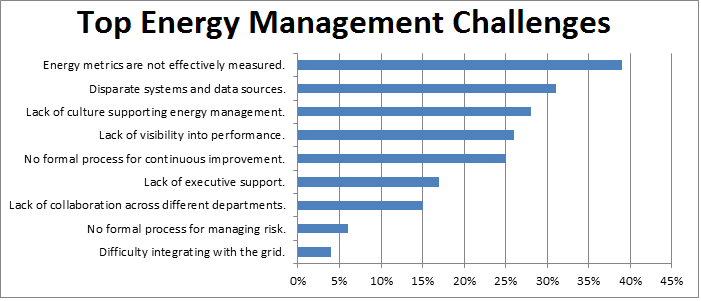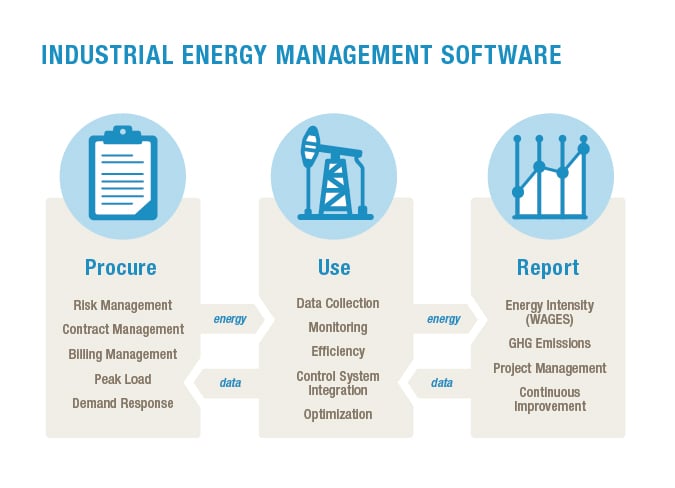Energy efficiency can be a fickle science. As companies evaluate projects that will deliver energy efficiency savings, it’s often the strategic use of mathematics that will dictate the decision. Hurdle rates, or the minimum required rate of return on an investment, have to be calculated to determine whether or not a project’s worth pursuing.
Industrial Energy Management (IEM) software is quite possibly one of the most impactful energy efficiency investments a company can make. Though, because its benefits can be indirect and long-term, it can be very challenging to accurately estimate an ROI. As a consequence, companies are much more hesitant to undertake such an investment.
In this post, we’ll examine some of the challenges with projecting an ROI for IEM software, as well as the main contributing factors for a successful IEM software investment.
Understanding the Benefits of IEM Software
In a recent LNS Research survey on Industrial Energy Management, more than 100 executives responsible for making energy-related decisions were asked what their top energy management challenges were. Among all of the potential responses (listed in the chart below), challenges with effectively measuring energy metrics and having too many disparate systems and data sources ranked at the top.

Interestingly, overcoming these two challenges—and many others on this chart for that matter—can be accomplished with an investment in IEM software.

Consolidating a number of traditionally disparate systems, data sources, and processes (as shown in the infographic above), IEM software automates the collection of energy data, and provides the needed workflow and analytics capabilities to ensure companies continuously improve performance and don’t flatline or even regress as equipment ages. These capabilities are critical for sustaining and gaining energy efficiency over time.
So, with these benefits, what’s stopping organizations from making an investment in industrial energy management software?
Where's the Hesitation with Industrial Energy Management Software Investments?
It's in the anticipated ROI. When discussing ROIs and hurdle rates for energy efficiency projects, it’s important to differentiate between hardware- and software-related projects. Because hardware is typically implemented and then delivers a benefit, the immediate value can be much more quantifiable. With software, there are a variety of factors that can impact the ROI, and software vendors’ claims for efficiency savings tend to be more qualitative.
Let’s take a closer look into each:
- Hardware-related energy efficiency projects: In calculating ROI and anticipated hurdle rates for hardware-related energy efficiency projects, manufacturers’ claims for efficiency gains on lighting, compressed air, refrigeration, motors, drives, and so on will be used. For this type of investment, you typically know your own usage and can pair that against the anticipated savings to determine if an investment’s worthwhile.
- Software-related energy efficiency projects: With IEM software, the challenge is that there’s no clear claim for how it will save money. In contrast to, for instance, a lighting retrofit manufacturer, a software vendor can’t tell a prospective buyer its solution’s going to save them 25% in a certain period of time. With the number of factors that impact software-related energy efficiency projects, it would be nearly impossible to make that type of claim.
Major Factors Contributing to a Higher ROI for IEM Software
The success of energy management software greatly depends on the leadership and business processes that surround the software implementation and drive action among employees. It's as much a people and process issue as it is a technology one. Because of this, it’s often up to executives to honestly assess a company’s capabilities and potential for savings, which, as stated above, isn't always straight forward.
In conjunction with an investment in technology, the following people and process measures can really help to drive up the ROI for IEM software:
People:
- Having an executive position that manages overall energy management (CSO or Energy Director)
- Developing a strong collaborative management structure that aligns energy with other sustainability initiatives and plant operations
- Establishing a culture that supports energy management initiatives across all areas of business, IT, procurement, operations, supply chain, and more
- Using third-party expertise and audit capabilities to assess energy performance and gaps; this should go beyond just simple audits to include change management and software expertise
Processes:
- Leveraging and incorporating continuous improvement models such as ISO 50001, SEP, and ENERGY STAR, into existing operational excellence initiatives
- Centrally managing end-to-end business processes for continuous improvement, reporting, energy procurement, energy use, and the approval of energy efficiency projects
- Standardizing only processes that create synergies across the enterprise and starting with those that can deliver quick wins like demand response and load shedding
Making a Stronger Case for IEM Software
Many industrial companies today have access to capital for reducing the use of energy. Sometimes this comes from internal capital budgets and sometimes from external sources such as grants from utilities for improved energy efficiency. Unfortunately, investments in IEM software are often still passed over or postponed, even though in many cases IEM software can deliver a higher ROI than traditional hardware-based efficiency projects and can even validate the anticipated benefits from these hardware-based efficiency projects. From talking to many executives responsible for these decisions, the number one reason IEM software projects aren't approved is because of the percieved uncertainty in benefits of IEM software due to the dependence on process and leadership excellence.
Clearly this means there’s still considerable work to be done to quantify the benefits and reliability of IEM software for driving performance benefits. Analyst firms like ours and others need to continue to quantify and communicate how the people and process pieces are compounding factors on how effective the technology can be.
In our IEM best practices guide we highlight some of the critical business processes needed to ensure you get the most out of your IEM software. In future research we will also provide benchmark data by industry that shows how much different companies are saving on energy by implementing IEM software. If your company has already implemented such software, please share your story by registering for an account and completing the energy survey.